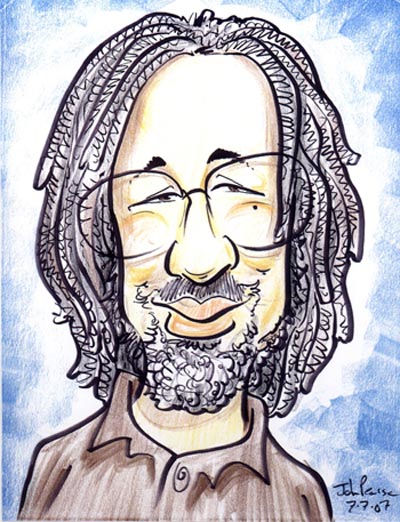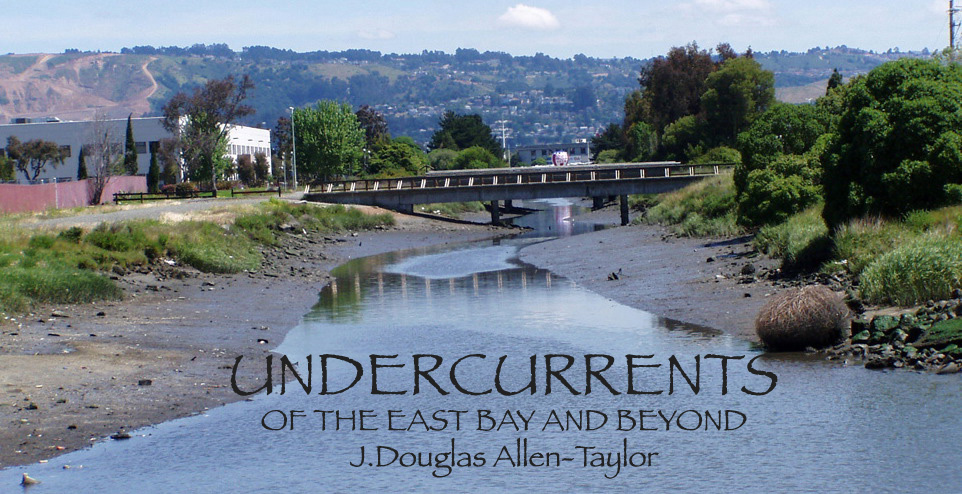|
|
A LOOK AT LOCAL CANDIDATE DEBATES
April 18, 2008
Running for elected office—especially for local, elected office—can be an extraordinarily stressful time, as candidates struggle to get their messages heard and understood amidst the general cacophony.
Thus it is not surprising that Oakland City Council At-Large candidate Charles Pine takes me to task in the Daily Planet’s letters section for what he says is my misquoting of one his statements during a recent League of Women Voters candidates’ forum.
In an April 11 UnderCurrents column, I wrote that Mr. Pine had mentioned sideshow culture and “boom boxes” specifically while talking about how crime and violence are ruining Oakland. In rebuttal, Mr. Pine writes: “I referred not to boom boxes but to boom cars, vehicles equipped with speakers that blast hundreds of watts of pounding bass. ‘Boom car’ is a street term; perhaps Mr. Allen-Taylor would like to get out of his office more often.”
My notes from the debate reflect “boom boxes” rather than “boom car,” but I’ll defer to Mr. Pines’ memory—since he was the one who said it—and apologize for the error. I have one or two things to quibble about concerning Mr. Pine’s political platform. Whether or not he is more concerned about loud music coming from a handheld speakerbox or a moving car is not one of them.
(I’ll offer no rebuttal his “get out of his office more often” remark. In the absence of any direct knowledge of me or my work habits—which I don’t believe Mr. Pine has—such a comment is, well, silly.)
But the exchange highlights what I believe is a more serious problem with this campaign season. For the first time in many years, the inner East Bay has a wide array of hotly-contested political races, from Senate District 9 (now held by the outgoing Don Perata) to Assembly District 14 (now held by the outgoing Assemblymember Loni Hancock) to the crowded race Mr. Pine is running in—At-Large Oakland City Council—to challenges to Oakland City Councilmembers in several districts as well as serious races for the newly-empowered Oakland School Board.
Unfortunately, the process hasn’t kept up with what could be very lively and informative campaigns.
Perhaps with no clear plan, but only by force of habit, we have developed two major types of forums—sometimes optimistically called “debates”—by which candidates are allowed to present their views, side-by-side, to the public. The first are the endorsement sessions sponsored by various organizations. The second are the forums sponsored by the League of Women Voters, most of which are taped at Oakland City Hall, and then rebroadcast over Oakland’s cable station, KTOP. For different reasons, the two venues have identical problems: neither give the public much of an opportunity to explore and understand the differences between the candidates.
Although none of the candidates will talk about this publicly—for obvious reasons—some candidates privately complain that decisions made in the endorsement debates have nothing to do with anything said during the debates. And how could it be otherwise?
In March of 2006, I went over to the Alameda County Democratic Lawyers Club endorsement meeting on the Jack London waterfront, in part to hear the debate between Oakland Mayor Jerry Brown and Los Angeles City Attorney Rocky Delgadillo, since it was the only time the two men had planned a head-to-head matchup in their race for the Democratic Party’s nomination for California Attorney General. But I also wanted to hear the debate between Sandré Swanson and Oakland City Attorney John Russo in their race for the 16th Assembly District Democratic Party nomination.
The Brown-Delgadillo AG race got all of the attention in the next day’s Oakland Tribune, getting the first 15 paragraphs and the headline. Concentrating on the Brown-Delgadillo matchup was to be expected in the city’s newspaper, with Oakland’s mayor one of the candidates for statewide office. What was interesting was that the Tribune gave no coverage to the other races involved in the lawyers club debate. Following details of the Brown-Delgadillo debate, the Tribune story said that “Also debating at Friday's event…”, thereafter merely giving a listing of the races and the candidates.
Unfortunately, the debate itself was little better. Nine candidates in four separate races were asked to present one-minute answers to various posed questions as the assembled attorneys sipped wine and munched on lunch. It is hard to believe that those attorneys could glean much from the limited answers to limited questions given by Mr. Russo and Mr. Swanson. Instead, as candidates privately complain about the endorsement meeting process in general (not the Alameda attorneys’ process in particular, but all of them), the only way for an organization member to give a fair and conscientious vote is by having come to the endorsement meeting with their minds already made up.
The endorsement meeting debates, in other words, are not designed to unveil information about the campaigns, but only to put a neat and pleasing cover on a process wherein the decisions—if not a foregone conclusion—are reached by the membership resorting to other means to get their information. Nothing underhanded or wrong implied in this. Only that for a voter looking to make their decision based upon how the candidates answer detailed questions head-to-head, the endorsement debates are not the best way.
Unfortunately, although the League of Women Voters candidate forums do not contain an endorsement at the end, these forums suffer from a similar problem: too many candidates, too many questions, not enough time. Typical League candidate forums run an hour apiece—whether they involve two candidates or five—with the candidates given a minute to answer questions.
The League forums have an added twist. In an attempt to ask questions that the public, ourselves, are interested in, the League solicits written questions from the audience prior to and during the debates and, after screening and sorting, those are the questions which are asked.
There are two problems with this type of format.
The first is that, bless their hearts, most people don’t know how to ask a question in a political forum. Most of the questions allow the candidates to give a generalized answer if they want, without getting to the heart of the matter. And sometimes, while the questions may be of some interest, they are not of enough interest to have been included in the debate for that campaign.
In a recent League debate in the Oakland Council District Five race, for example, in which incumbent Ignacio De La Fuente is being challenged by two opponents, the candidates were asked about their position on term limits for Oakland City Council. Mr. De La Fuente has served 16 years on City Council, and perhaps the question was aimed, in some way, at that fact. But term limits are generally unpopular in Oakland and, to my knowledge, there has not been a serious attempt either to bring the matter before City Council or to bring it to the voters in the form of a ballot measure. As such, it caught the candidates by surprise, particularly challenger Mario Juarez, who had to answer it first.
But more important, the one-and-done type of questioning format for the League of Women Voters forums does not allow for follow-up questions, either from the audience or the moderator, to make sure that, at the very least, the original question was understood and answered. (I hate to jump on the League about this, since they are the only group stepping up to the plate to provide non-endorsement forums in these campaigns. Without them, we’d have nothing. Sorry guys, and please take this as constructive criticism.)
We return to Mr. Pine.
In his letter to the Daily Planet complaining about my references to his campaign, Mr. Pine writes that while he is not a law-and-order ideologue (something I never accused him of), he does “call for increasing Oakland’s police force, currently half the size of most major cities, to a modest 1,100. … Would Mr. Allen-Taylor tell Atlanta, Boston, St. Louis and all those other cities to cut their police forces in half? Then their residents could live and die as we do in Oakland. All we want in Oakland is the relative peace of an average American city.”
I have visited Mr. Pine’s websites, both for his campaign and for the Oakland Residents For Peaceful Neighborhoods of which he is the co-founder, and have seen this particular argument before. On the front page of his campaign website, he writes that Oakland has 18 police officers per 10,000 residents, only half the number that “Atlanta (35), Boston (34), Cleveland (34), St. Louis (39) and most major cities have. Fewer than San Francisco. Fewer than Los Angeles.”
But judging how many police officers Oakland should be gearing towards by looking at how many officers are in other cities is something like a family deciding what kind of car they should have by walking around the neighborhood and seeing what is parked in other peoples’ garages. The question is not what the other cities are doing. The question is, at the present time, what can Oakland afford?
The cities cited by Mr. Pine—Atlanta, Boston, Cleveland, St. Louis, San Francisco, and Los Angeles—are all major regional retail centers, with no city of comparable size in their vicinity to provide competition. Thus, they have enormous tax bases to draw upon that is not available to Oakland. Much of the retail sales tax revenue in Oakland that might go to Mr. Pine’s increased police force—or to other city services, if that’s what we decide we want—instead go the retail mall developments in Emeryville, San Leandro, Alameda, Hayward, and other surrounding East Bay cities, and across the bridge to San Francisco. The question for Oakland City Council candidates is not how they would spend money we don’t currently have—an interesting exercise, but not very probative—but how they would gather new revenue to make spending for their preferred programs possible.
Alternatively, candidates—beginning with Mr. Pine—might want to say, in detail, what existing programs they would cut or city positions they would end in order to make up the shortfall.
If you think I am picking on Mr. Pine, I am not. He is an easy target only because he is one of the few candidates this campaign season—or any campaign season—who has committed himself to a specific number and a specific solution, and has not tried to hide behind generalities. I admire that, even while in disagreement. It is my hope that with this abundance of able and qualified candidates in so many fields, we could figure out a way to have a campaign that could draw out more of the differences and specifics from candidates, so that the public could be in a better position to make an informed choice.
So far, we haven’t.
|

